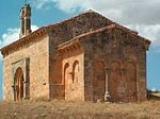
Coruña del Conde
Encyclopedia
Coruña del Conde is a village and municipality
in the southern province of Burgos, Castile and León
Spain
. The Arandilla River
runs through it.
It contains the ruins of an ancient Muslim
castle, later converted for use by Castilian
counts, which sits atop a hill that looks over the town. It also contains the Romanesque
chapel of Santo Cristo. The village claims to be the venue for the first human flight by air pioneer Diego Marín Aguilera
, who was born in the town (a plane was placed by the Spanish Air Force
by the castle as a reminder of this claim). It was the birthplace of Bishop Agustín of Popayán
, Colombia
.
Colonia Clunia Sulpicia, one of Hispania's main cities and a conventus iuridicum capital of Hispania Tarraconensis
, was located 2 km away from the village. At Clunia, Emperor Galba
was proclaimed emperor by his legions and from there marched to Rome. Stones from the ancient city were used in the construction of buildings of the area, such as churches, arches, walls, castles or even palaces at Peñaranda de Duero
.
Municipality
A municipality is essentially an urban administrative division having corporate status and usually powers of self-government. It can also be used to mean the governing body of a municipality. A municipality is a general-purpose administrative subdivision, as opposed to a special-purpose district...
in the southern province of Burgos, Castile and León
Castile and León
Castile and León is an autonomous community in north-western Spain. It was so constituted in 1983 and it comprises the historical regions of León and Old Castile...
Spain
Spain
Spain , officially the Kingdom of Spain languages]] under the European Charter for Regional or Minority Languages. In each of these, Spain's official name is as follows:;;;;;;), is a country and member state of the European Union located in southwestern Europe on the Iberian Peninsula...
. The Arandilla River
Arandilla River
The Arandilla is a river found in the southeast of Burgos province, Spain. It runs through the following towns:* Arandilla* Baños de Valdearados* Brazacorta* Coruña del Conde* Fresnillo de las Dueñas* Hontoria de Valdearados* Peñaranda de Duero...
runs through it.
It contains the ruins of an ancient Muslim
Muslim
A Muslim, also spelled Moslem, is an adherent of Islam, a monotheistic, Abrahamic religion based on the Quran, which Muslims consider the verbatim word of God as revealed to prophet Muhammad. "Muslim" is the Arabic term for "submitter" .Muslims believe that God is one and incomparable...
castle, later converted for use by Castilian
Kingdom of Castile
Kingdom of Castile was one of the medieval kingdoms of the Iberian Peninsula. It emerged as a political autonomous entity in the 9th century. It was called County of Castile and was held in vassalage from the Kingdom of León. Its name comes from the host of castles constructed in the region...
counts, which sits atop a hill that looks over the town. It also contains the Romanesque
Romanesque architecture
Romanesque architecture is an architectural style of Medieval Europe characterised by semi-circular arches. There is no consensus for the beginning date of the Romanesque architecture, with proposals ranging from the 6th to the 10th century. It developed in the 12th century into the Gothic style,...
chapel of Santo Cristo. The village claims to be the venue for the first human flight by air pioneer Diego Marín Aguilera
Diego Marín Aguilera
Diego Marín Aguilera was a Spanish inventor who was an early aviation pioneer. Born in Coruña del Conde, Marín became the head of his household after his father died. Marín was forced to take care of his seven brothers, and worked as an agricultural laborer, tending his animals and fields...
, who was born in the town (a plane was placed by the Spanish Air Force
Spanish Air Force
-The early stages:Hot air balloons had been used with military purposes in Spain as far back as 1896. In 1905, with the help of Alfredo Kindelán, Leonardo Torres y Quevedo directed the construction of the first Spanish dirigible in the Army Military Aerostatics Service, created in 1896 and located...
by the castle as a reminder of this claim). It was the birthplace of Bishop Agustín of Popayán
Popayán
Popayán is the capital of the Colombian department of Cauca. It is located in southwestern Colombia between Colombia's Western Mountain Range and Central Mountain Range...
, Colombia
Colombia
Colombia, officially the Republic of Colombia , is a unitary constitutional republic comprising thirty-two departments. The country is located in northwestern South America, bordered to the east by Venezuela and Brazil; to the south by Ecuador and Peru; to the north by the Caribbean Sea; to the...
.
Colonia Clunia Sulpicia, one of Hispania's main cities and a conventus iuridicum capital of Hispania Tarraconensis
Hispania Tarraconensis
Hispania Tarraconensis was one of three Roman provinces in Hispania. It encompassed much of the Mediterranean coast of Spain along with the central plateau. Southern Spain, the region now called Andalusia, was the province of Hispania Baetica...
, was located 2 km away from the village. At Clunia, Emperor Galba
Galba
Galba , was Roman Emperor for seven months from 68 to 69. Galba was the governor of Hispania Tarraconensis, and made a bid for the throne during the rebellion of Julius Vindex...
was proclaimed emperor by his legions and from there marched to Rome. Stones from the ancient city were used in the construction of buildings of the area, such as churches, arches, walls, castles or even palaces at Peñaranda de Duero
Peñaranda de Duero
Peñaranda de Duero is a village and municipio located in the province of Burgos, Castile and León, Spain. According to the 2004 census , the municipality has a population of 583 inhabitants....
.

